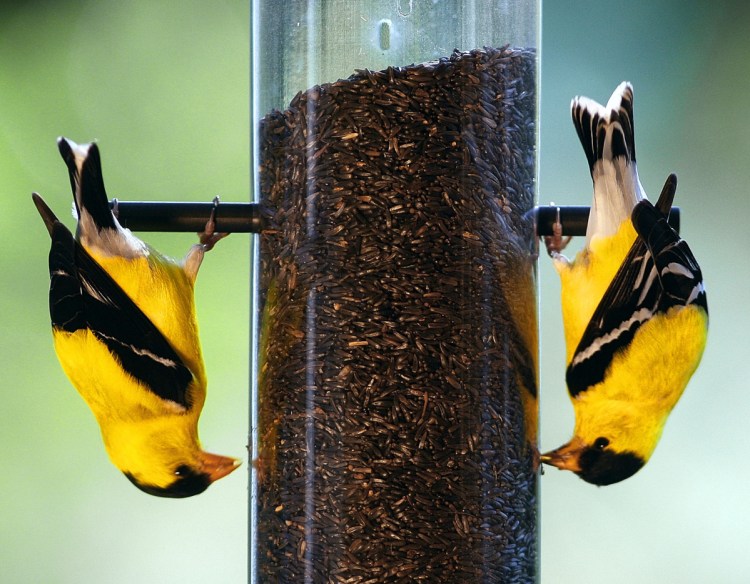The choir has been replaced by a quartet. On my regular walk through the neighborhood and along Messalonskee Stream in Waterville, the avian music has diminished.
In June and early July, at least 30 voices were in the morning chorus. Now, the songs of American robins, northern cardinals, song sparrows and American goldfinches are the only regular tunes offered.
Of course, the reason for the reduction is that most of our nesting flycatchers and songbirds have finished nesting now. The tree swallow or red-eyed vireo you see now may be a migrant from the north, temporarily replacing our post-breeding birds that have already departed on their southward migration.
But one of the species now singing in full throat is just getting started with nesting. American goldfinches will nest into early September.
Male goldfinches, in their breeding plumage, are well known by all. However, the more drab, olive-colored female is sometimes confusing. In the winter, both sexes wear a rather somber plumage.
The American goldfinch is a member of the finch family, the Fringillidae. Other finches, like the house finch, evening grosbeak and pine siskin, do not undergo a complete body molt in the spring. Not so the goldfinch. These birds molt all their body feathers, retaining only the wing and tail feathers. Males are transformed from a muted olive color to the beautiful yellow and black of the breeding season. I am sure you have enjoyed watching the transformation of goldfinches in the spring. First, a little yellow appears, gradually replacing all the duller feathers. David Sibley has prepared a wonderful animation to show the molting process in goldfinches at sibleyguides.com. Search for plumage cycle.
Why do goldfinches begin nesting so late in the season? Some ornithologists think their spring molt may be the explanation. Molting is an energetically expensive activity. Replacing all the body feathers is much costlier than replacing only some of the feathers.
The many yellow feathers a male American goldfinch produces in the spring are colored by carotenoid pigments. These pigments cannot be produced by the bird, but rather must be acquired from plants. The seeds that goldfinches feed on provide the carotenoids needed. It has to be an energetically expensive proposition to assimilate all of those carotenoids to transform a male’s appearance.
American goldfinches may need some time in the early summer to recover from the demands of the molt process.
Other ornithologists have noted that American goldfinch nesting seems to be closely tied to the flowering of thistle plants. Courtship usually begins about the time that thistle flowers appear. By the time the eggs have hatched, thistle seeds are available for the parents to feed themselves and their young.
During courtship, look for a couple of flight displays that are distinctly different from the normal undulating flight of a goldfinch. One type is called butterfly flight. A male will fly with steady, slow wing beats, maintaining a constant height above the ground. The male circles over a prospective nesting area, singing its rambling, warbling song. The displaying male is frequently joined by other males, all circling over a nesting area and singing. It’s quite a display to see.
Later in the breeding season, the moth flight can be seen. A male uses rapid wing beats to hover for a short period of time. This display is seen just before mating. Sometimes, a female will perform the moth flight.
Although goldfinches are regulars at bird feeders, learning some of their calls will allow you to detect goldfinches flying overhead. A characteristic flight call can be rendered as per-chi-co-ree or potato chip.
Goldfinches also have a characteristic, whiny note, which serves as an alarm call. The scientific name of the goldfinch is Spinus tristis; tristis means sad and refers to this whiny call.
Herb Wilson teaches ornithology and other biology courses at Colby College. He welcomes reader comments and questions at
whwilson@colby.edu
Send questions/comments to the editors.



Success. Please wait for the page to reload. If the page does not reload within 5 seconds, please refresh the page.
Enter your email and password to access comments.
Hi, to comment on stories you must . This profile is in addition to your subscription and website login.
Already have a commenting profile? .
Invalid username/password.
Please check your email to confirm and complete your registration.
Only subscribers are eligible to post comments. Please subscribe or login first for digital access. Here’s why.
Use the form below to reset your password. When you've submitted your account email, we will send an email with a reset code.